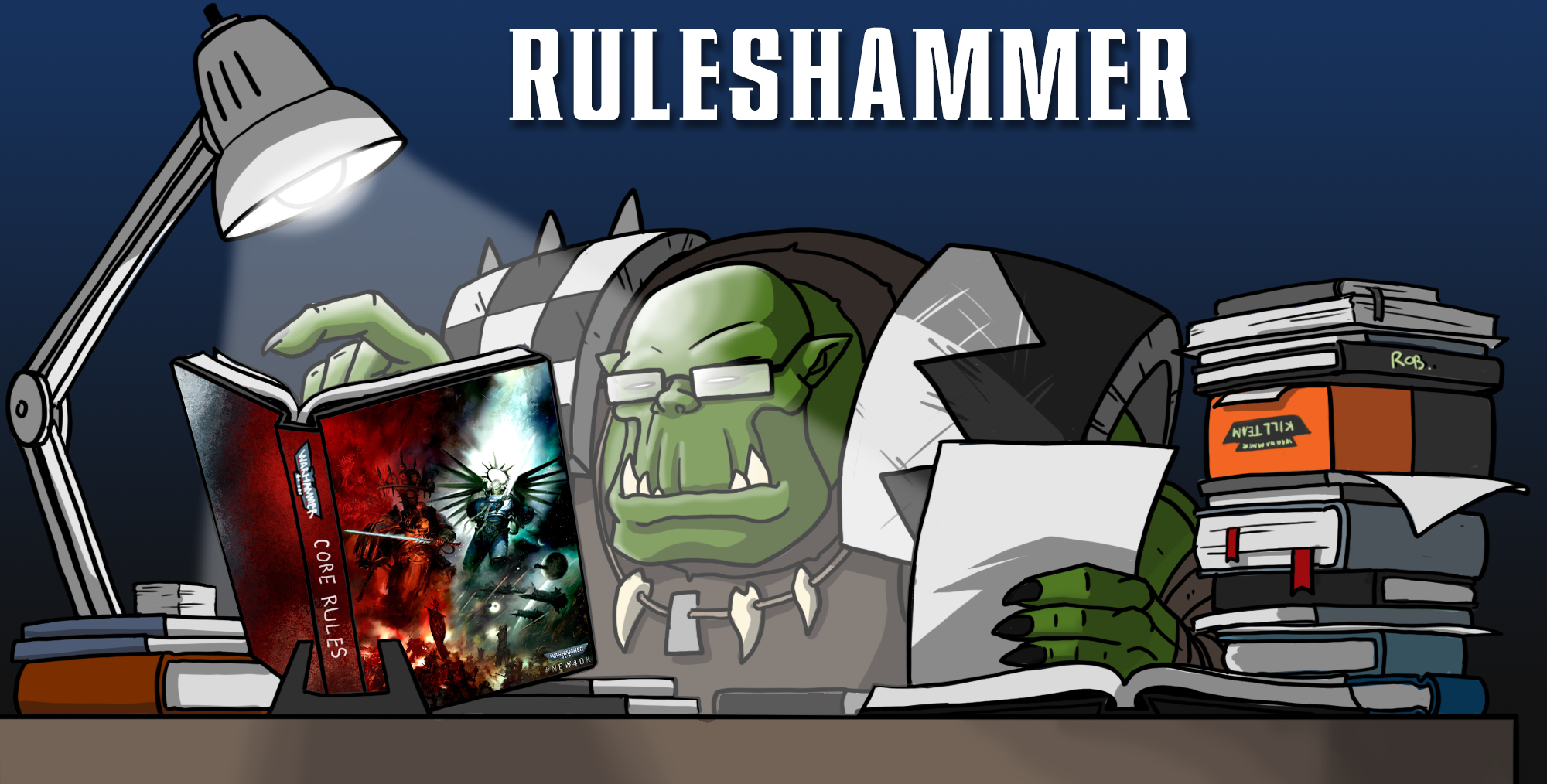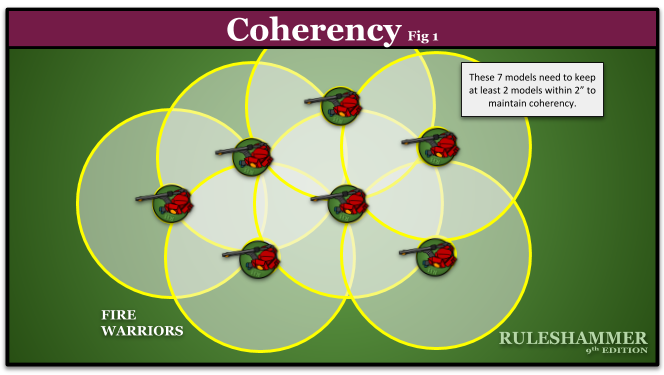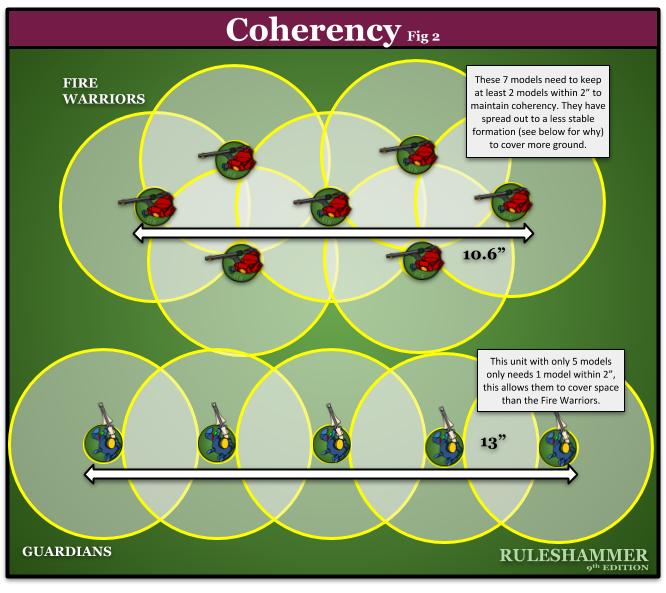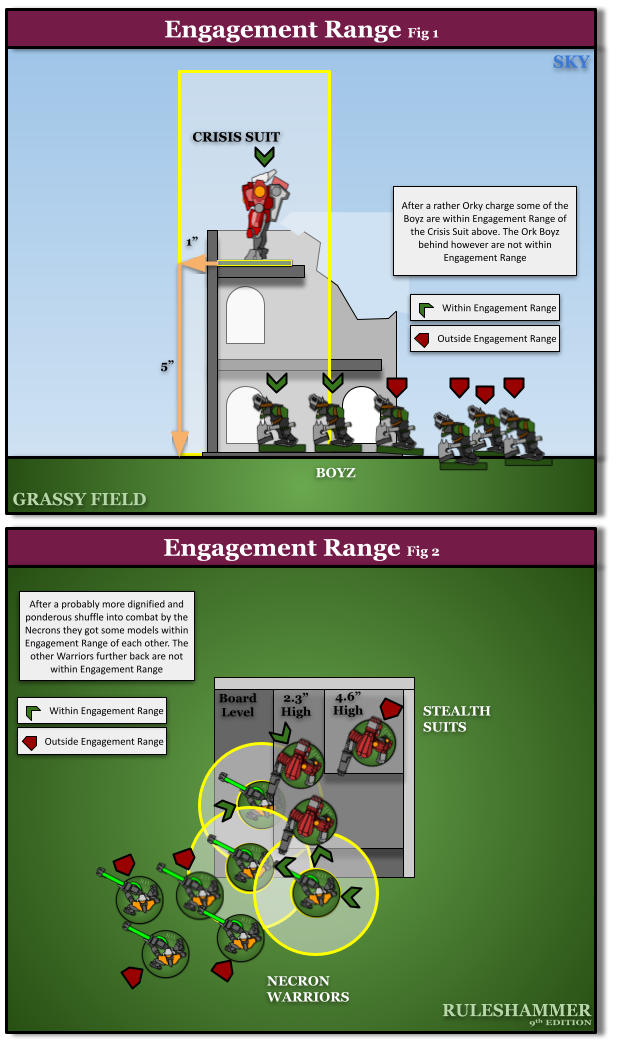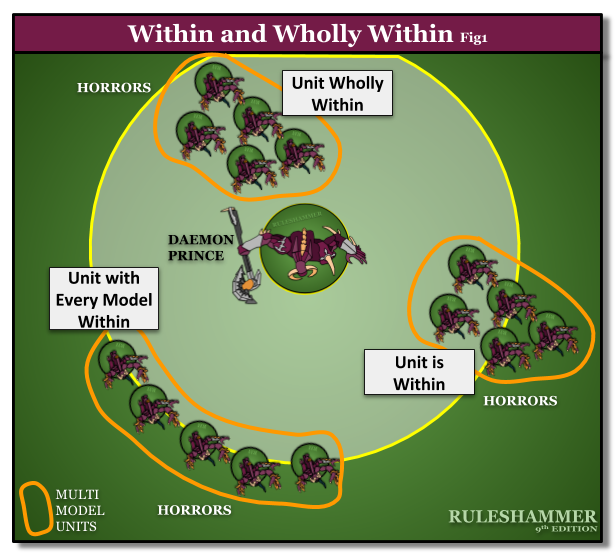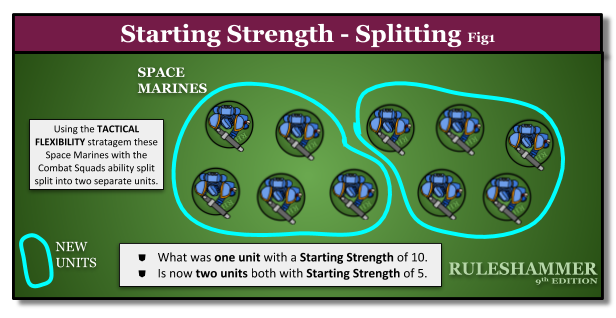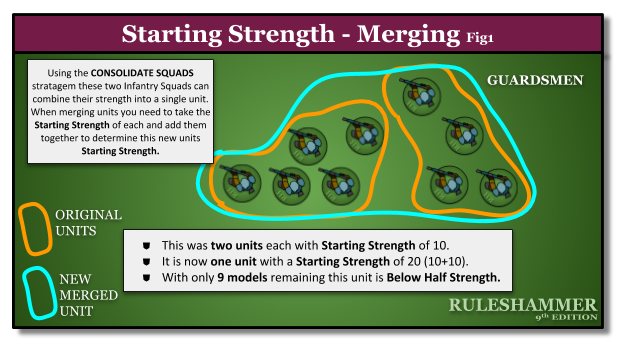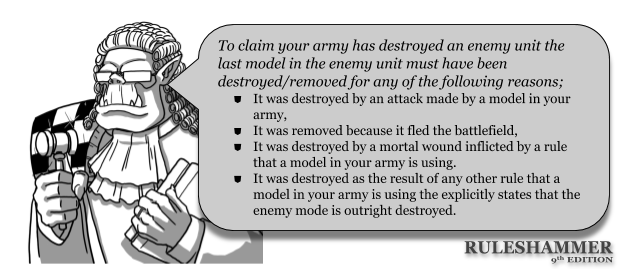With the new edition nearly upon us, we had Rob “Vre’kais” Chilton sit down with the new rulebook in the Indomitus boxed set and write his thoughts (in great detail) on the new rules – what’s changed, what needs clarification, and what you need to know. Starting with today’s massive update, he’ll be doing daily posts over the next two weeks talking about key changes to the rules and going over each phase of the game.
Welcome to 9th edition! The new rulebook is full of changes and clarifications but essentially these new rules are, at their core, less ambiguous than the prior edition and while they come across a bit wordy at points, they do a good job removing multiple interpretations. This is great. So what has changed?
Unit Coherency
This is a significant change especially for armies fielding large units; this change marks the end of the “Conga line” approach to unit coherency.
The New Coherency Rule
A unit that has more than one model must be set up and finish any sort of move as a single group, with all models within 2″ horizontally and 5″ vertically of at least one other model from their unit. While a unit has six or more models, all models must instead be within 2″ horizontally and 5″ vertically of at least two other models from their unit.
So there’s two main changes here from 8th to 9th: The 6” vertical limit has been reduced to 5” in the new edition (the height of a single floor of Sector Imperialis/Mechanicus buildings) and if a unit has 6 or more models then each model needs to be within 2” of 2 models now.
What does this look like on the board?
These changes combined with a few others will see models in larger units moving in tighter groups.
This rule isn’t without it’s quirks; for instance a unit of 5 models can actually cover a wider area than a unit of 7.
Coherency Checks
Let’s consider that formation for 7 models again. While in Coherency you need to be mindful of how the new Coherency Checks rules will need to be a factor in the models you chose to remove from a unit.
Each player must now remove models, one at a time, from any of the units in their armies that are no longer in unit coherency, as defined on page 4, until only a single group of models from the unit remains in play and in unit coherency.
Assuming you lose no more models to a Morale Test the models you remove when taking damage needs to take the coherency of the unit into account or you risk losing more models. For instance look at the example below:
Coherency checks are the real end to having hordes of models in long “conga lines;” lose too many models and spread them too thin and the unit can collapse down to its last 5 models. There’s more to explore here rules wise but I will save this for a future article focused more specifically on these mechanics.
Engagement Range
Engagement Range codifies the concept of “within 1″ of the enemy” into a single term for reuse across the rules, and also adds a new feature – in 9th edition it now has a vertical component (5″) allowing for fights across different elevations in ruins, over crates or around barrels. No longer is a model on a 1.1” tall plinth immune to combat… ANKLES are back on the menu!
Engagement Range is now used as a catch all term for this cylinder and it affects how units move and how they fight so it’s important to understand to play out those phases correctly. One key part of the new Engagement Range other than resolving issues for things like Knights and Trygons is that is also clears up differences in the Hover Tank Rules like those I covered in this article on Transports – getting within 1″ of a hovering vehicle’s “footprint” now ensures you’re in engagement range thanks to the generous vertical allowance.
Measuring Distances
Measuring distances now has a proper section of the rules all to itself, the tyranny of Core Rules Page 2 is over. Has much changed though?
Distances are measured in inches (“) between the closest points of the bases of the models you’re measuring to and from. If a model does not have a base, such as is the case with many vehicles, measure to the closest point of any part of that model; this is called measuring to the model’s hull. You can measure distances whenever you wish.
Fundamentally this is pretty much the same as 8th: Measure base-to-base and measure in inches. What has changed though concerns what’s counted as a model’s “hull.” In 8th, FAQs indicated that hull considerations did not count Sponsons or Turrets, you may remember that caused me a bit of a headache about a month ago (Editor’s Note: This was a major point of contention in the Goonhammer offices. Voices were raised. Chairs were thrown. Friendships nearly ended). We at Goonhammer are now pleased to be able to confirm that Turrets are “real” once again. A model’s Hull is now “any part” of the model. This change has more effects on movement and shooting that I’ll cover the implications of in detail in future articles.
Wings: It does also make it a bit trickier for some vehicles with especially massive turrets or footprints to manage to be “wholly within” auras, as you need to fit everything.
Within and Wholly Within
These terms have been cleared up a lot. “Entirely Within,” the most confusing term of the old group, has gone and been replaced with rules that will now say they affect units if “every model in that unit is within.” (Editor’s Note: This brings the rules in line with Age of Sigmar, which only used the “within” and “wholly within” distinctions).
This change has major effects when it comes to the implementation of cover. I’ll be covering those implications later this week.
Wobbly Models
The rules for wobbly models are still there and they’re still a bit lacking. I’d really like for this to have made it clear that models need to be able to balance upright where you put them for you to use this rule for their real position. It does say;
Provided it is still physically possible to place the model in the desired location.
So that does preclude wobbly modeling half way through walls or half way up a ruin. (Corrode: there is greater clarity on this in the terrain rules, which specifically say that you can’t end a move halfway up a wall or similar). Generally though models needing to be perpendicular to the surface below them is how I tend to play, and anyone trying to stunt drive their models around the board should reflect on their shameful actions.
Dice and Dice Modifiers
This game still uses dice. It will still use the word dice both as singular and plural as is common (seriously I’ve had people try to argue that dice as a plural meant they could re-roll entire attacks as it said to re-roll “the dice”). (TheChirurgeon’s note: For reasons I will never understand, Brits refer to a single “dice” rather than a “die”). There is a key clarification though.
All modifiers (if any) to a dice roll are cumulative; you must apply all division modifiers before applying all multiplication modifiers, and before applying all addition and then all subtraction modifiers. Round any fractions up after applying all modifiers.
The dice modifiers now have a set order of operations, and they are the “normal” mathematical order (often called PEMDAS or BODMAS);
- Division
- Multiplication
- Addition
- Subtraction
This is a massive improvement on the vague and ambiguous order that we had at the start of 8th and will clear up a lot of interactions.
Re-rolls
Re-roll are unchanged. They still happen before modifiers and “unmodified 1s” are still the result after re-rolls are applied.
Wings: This does mean that any codexes still cursed with the “old” re-roll wording that left out “can” need to cross their fingers for the big update FAQs to bring them some help.
Starting Strength and Half Strength
This is a newly defined concept for 9th but essentially it’s a state that units can now find themselves in. It does have a few quirks though rather than the simple below or above half the unit, that seems obvious when units start to split or merge as they can infrequently do.
If a rule is used to split a unit into multiple units during the battle, the Starting Strength of each individual unit is changed to be equal to the number of models in that unit.
If several units merge together to form a single combined unit during the battle, add the Starting Strengths of all the individual units together to determine the new Starting Strength of the combined unit, and use this value to determine if the combined unit is below Half-strength.
The last point to make is at what number of models a unit becomes Half-strength:
While the number of models in a unit is less than half its Starting Strength, that unit is said to be below Half-strength.
So the number remaining needs to be LESS than half. A unit of 20 reduced to 10 is not less than half. A unit with a starting strength 15 with 7 models remaining would be though, as half would be 7.5 models.
Destroyed Units
This change was a surprise to be sure, but a welcome one.
Some rules will only trigger if an enemy unit was destroyed by you, or by a model or unit from your army – this means that the last model in the enemy unit was destroyed by an attack (pg 18) made by a model in your army, or it was destroyed because it fled the battlefield (pg 23), or it was destroyed by a mortal wound (pg 19) inflicted by a rule that a model in your army is using, or it was destroyed as the result of any other rule that a model in your army is using that explicitly states that the enemy model is outright destroyed. Enemy units that are destroyed by any other means are not destroyed by you, or by a unit or model from your army. [Core Rules PDF Pg6]
Essentially if you didn’t hit it, then it doesn’t count as being destroyed by you (unless it runs away). This will take a bit of thought sometimes; if you destroyed a vehicle and that vehicle exploded killing a model from a unit, and then later on that unit failed a morale test and lost the remaining models in the unit. Then that unit fled, and despite not being directly attacked by an opponent that unit would count as destroyed by them as fleeing is one of the accepted conditions. There’s no bullet points for this though so here’s some from us:
Wings: This is extremely welcome – one of the low key most frustrating confusions that sometimes arose when dealing with secondary objectives in mission packs was whether a particular method of a unit dying “counted”. This makes those debates academic, and I’m pleased they took the time to catch it.
Modifying Characteristics
Similarly to Dice Rolls, Modifying Characteristics now follows the same order as dice rolls with one extra step:
- Rules that Set A Characteristic to a Value
- Division
- Multiplication
- Addition
- Subtraction
The other part this new version clears up is how to determine random characteristics for a unit. Essentially a random movement stat if required should be determined for the entire unit once (so that it can stay together) but all of the other characteristics are determined per model or per weapon.
In addition, modifiers from equipment are now processed alongside those from other abilities, with the impact that weapons that double your strength are no longer quite as effective when combined other buffs.
Wings: There’s a few units that get slammed surprisingly hard by this, with Repentia being the most notable. Pretty sure that Magnus can’t get himself to S20 any more either, so everything’s coming up Warlord Titan.
Out-of-Phase Actions and Rules
This is a new addition to the rules brought in from 8th’s FAQs. It establishes clearly what the “as if _____ phase” wording allows. So if you use a rule or ability that has a unit act as if it is the Movement phase, then all rules that would normally apply to a unit in that phase do so. So that unit might Advance, they still can’t move within the engagement range of other units, they can make a move that gains some benefit from the FLY keyword, etc. The exception to this is that you can’t use a Stratagem that specifies that it is “used in the Movement phase” on a unit that is currently only acting “as if in the Movement phase”.
The Command Phase
The Command Phase is brand new for 9th and consolidates a few different things into one phase of the game. Essentially everything that happened in the void between the start of a turn and the movement phase, the “before the movement phase” rules.
The other main part of the Command Phase is that it’s also where you gain your 1CP per turn bonus for having a Battleforged army. This does mean that this gain is asymmetric: The player going first will always gain theirs before their opponent. So if by the end of turn 3 both players have gotten down to 0 CP, the player going first will gain 1 and the player going second will remain on 0. This will prevent them from using stratagems like Overwatch, despite prior assertions that you’d always be able to Overwatch thanks to the Command Phase CP bonus. Keep this in mind.
TheChirurgeon’s Note: There are also a number of abilities that are likely to move to the Command phase, particularly if they activated at the start of your turn or the battle round. The most notable example of these is Space Marine litanies – the Indomitus Datasheet for Space Marine Chaplains now has litanies being chanted in your Command phase. There’s no reason to believe this won’t be the case for Marine Chaplains moving forward, and it has major implications, both good – it’s easier to remember to do them if they’re on your turn, and bad – Not having litanies active on your opponent’s first turn if you are going second is a massive nerf to their power, especially the defensive litanies like Litany of Faith, Litany of Divine Protection, or if you’re a Chaos Space Marines player, Benediction of Darkness. If I were being a bit of a pessimist, I’d suggest that this further underlines why going first in 9th is a massive advantage.
Sequencing
Finally, sequencing has changed: If abilities happen at the same time, the player whose turn it is gets to decide the order, unless it’s happening before or after a battle in which case a roll off determines which player decides on the order. Exactly as it was in 8th but it’s not squeezed into a corner. Which leads me nicely onto my thoughts on the new formatting.
Ruleshammer’s Views on the Format
I’ve seen it said plenty that the rules are a bit “wordy” and that they seem to be written for “Rules Lawyers”. Yes. I don’t think that’s an unfair statement but in my opinion Games Workshop have done a great job with 9th of taking 8th as a foundation and clarifying all the bits that used to come out to several different interpretations down to just one. Then for like 95% of these rules they’ve clearly summarised the key points with bullet points after each rule. They’ve elevated a significant amount of rules from obscurity squeezed into the margins on 8ths Core Rule Pages to prominent positions in the new edition but still maintaining concise and precise language.
Have any questions or feedback? Got a rules question you want answered? Drop us a note in the comments below, ask a question in our Ruleshammer form, or head over to r/ruleshammer to discuss.
